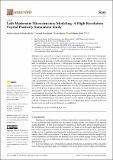| dc.contributor.author | Gallardo-Basile, Francisco-José | |
| dc.contributor.author | Naunheim, Yannick | |
| dc.contributor.author | Roters, Franz | |
| dc.contributor.author | Diehl, Martin | |
| dc.date.accessioned | 2022-05-27T18:00:51Z | |
| dc.date.available | 2021-09-20T14:16:17Z | |
| dc.date.available | 2022-05-27T18:00:51Z | |
| dc.date.issued | 2021-02 | |
| dc.date.submitted | 2021-01 | |
| dc.identifier.issn | 1996-1944 | |
| dc.identifier.uri | https://hdl.handle.net/1721.1/131339.2 | |
| dc.description.abstract | Lath martensite is a complex hierarchical compound structure that forms during rapid cooling of carbon steels from the austenitic phase. At the smallest, i.e., ‘single crystal’ scale, individual, elongated domains, form the elemental microstructural building blocks: the name-giving laths. Several laths of nearly identical crystallographic orientation are grouped together to blocks, in which–depending on the exact material characteristics–clearly distinguishable subblocks might be observed. Several blocks with the same habit plane together form a packet of which typically three to four together finally make up the former parent austenitic grain. Here, a fully parametrized approach is presented which converts an austenitic polycrystal representation into martensitic microstructures incorporating all these details. Two-dimensional (2D) and three-dimensional (3D) Representative Volume Elements (RVEs) are generated based on prior austenite microstructure reconstructed from a 2D experimental martensitic microstructure. The RVEs are used for high-resolution crystal plasticity simulations with a fast spectral method-based solver and a phenomenological constitutive description. The comparison of the results obtained from the 2D experimental microstructure and the 2D RVEs reveals a high quantitative agreement. The stress and strain distributions and their characteristics change significantly if 3D microstructures are used. Further simulations are conducted to systematically investigate the influence of microstructural parameters, such as lath aspect ratio, lath volume, subblock thickness, orientation scatter, and prior austenitic grain shape on the global and local mechanical behavior. These microstructural features happen to change the local mechanical behavior, whereas the average stress–strain response is not significantly altered. Correlations between the microstructure and the plastic behavior are established. | en_US |
| dc.publisher | MDPI AG | en_US |
| dc.relation.isversionof | http://dx.doi.org/10.3390/ma14030691 | en_US |
| dc.rights | Creative Commons Attribution | en_US |
| dc.rights.uri | https://creativecommons.org/licenses/by/4.0/ | en_US |
| dc.source | Multidisciplinary Digital Publishing Institute | en_US |
| dc.title | Lath Martensite Microstructure Modeling: A High-Resolution Crystal Plasticity Simulation Study | en_US |
| dc.type | Article | en_US |
| dc.identifier.citation | Materials 14 (3): 691 (2021) | en_US |
| dc.contributor.department | Massachusetts Institute of Technology. Department of Materials Science and Engineering | |
| dc.relation.journal | Materials | en_US |
| dc.eprint.version | Final published version | en_US |
| dc.type.uri | http://purl.org/eprint/type/JournalArticle | en_US |
| eprint.status | http://purl.org/eprint/status/PeerReviewed | en_US |
| dc.date.updated | 2021-02-05T14:15:15Z | |
| dspace.date.submission | 2021-02-05T14:15:15Z | |
| mit.journal.volume | 14 | en_US |
| mit.journal.issue | 3 | en_US |
| mit.license | PUBLISHER_CC | |
| mit.metadata.status | Authority Work Needed | en_US |
